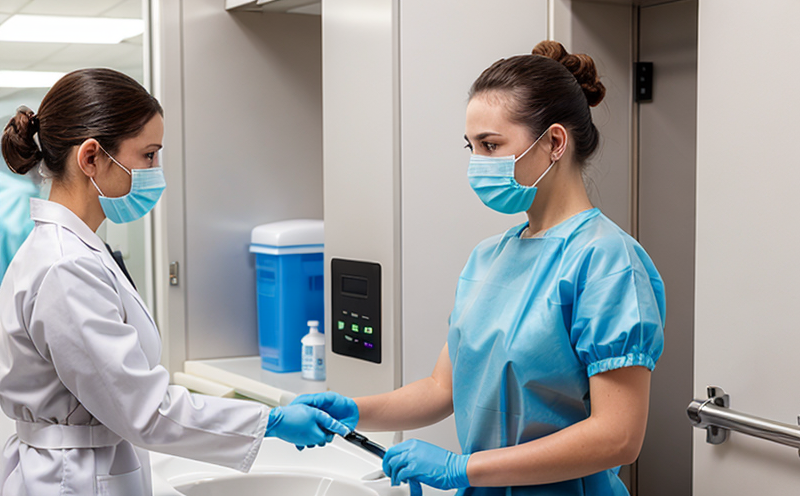GB T 24347 Evaluation of antibacterial finishes in fabrics
The GB/T 24347 standard is a pivotal guideline developed specifically for the evaluation of antibacterial finishes on textiles. This standard ensures that textile products maintain their antimicrobial properties over time, which is crucial for healthcare and hygiene products such as surgical gowns, masks, and bedding. Compliance with this standard helps manufacturers meet regulatory requirements while enhancing product quality.
The test procedure outlined in GB/T 24347 involves exposing the fabric to a standardized bacterial challenge followed by a rinse cycle designed to simulate real-world conditions. The effectiveness of the antibacterial finish is then assessed through colony-forming unit (CFU) counts, comparing pre- and post-treatment samples.
The standard also includes provisions for accelerated aging tests to evaluate long-term performance, ensuring that products continue to meet hygiene standards even after extended use or storage. This testing method helps in identifying potential durability issues early in the product lifecycle.
For quality managers and compliance officers, understanding GB/T 24347 is essential as it provides clear guidance on how to test for antibacterial finishes. This standard supports the development of consistent and reliable products that meet both domestic and international market demands. It also aids R&D engineers in optimizing formulations to achieve the desired level of antimicrobial efficacy while maintaining fabric performance.
Proper specimen preparation is critical; samples should be cut from the fabric using a defined method, ensuring they represent typical usage conditions. The test procedure involves several steps including the bacterial challenge, rinse cycle, drying, and CFU count.
| Step | Description |
|---|---|
| Bacterial Challenge | Exposure of fabric samples to a defined bacterial strain (e.g., Staphylococcus aureus). |
| Rinse Cycle | Simulated washing cycle with detergent and water. |
| Drying | Standardized drying conditions to ensure consistency in post-treatment sample preparation. |
| CFU Count | Determination of colony-forming units per gram (CFU/g) on the fabric surface. |
The testing process is not only about compliance but also about enhancing product performance. By adhering to GB/T 24347, manufacturers can ensure that their products meet stringent hygiene standards, thereby gaining a competitive edge in the market.
Scope and Methodology
The scope of GB/T 24347 covers the evaluation of antibacterial finishes on textiles using specific methods designed to assess the effectiveness of these treatments. The methodology includes several key components:
- Bacterial challenge with a defined bacterial strain.
- Simulated washing cycle under standardized conditions.
- Drying process following the rinse cycle.
- CFU count post-treatment.
| Component | Description |
|---|---|
| Bacterial Challenge | Involves exposing fabric samples to a standardized bacterial strain, typically Staphylococcus aureus. |
| Simulated Washing Cycle | A defined washing process using detergent and water at specified temperatures. |
| Drying Process | Standardized drying conditions to prevent variation in sample preparation. |
| CFU Count | Determination of the number of colony-forming units per gram (CFU/g) on the fabric surface. |
The CFU count is a critical metric used to evaluate the reduction in bacterial load after treatment. This standard also includes provisions for accelerated aging tests, which help manufacturers assess long-term performance and durability of antibacterial finishes.
Accurate specimen preparation is essential; samples should be cut from the fabric using defined methods that ensure they represent typical usage conditions. The testing process involves several steps including bacterial challenge, simulated washing cycle, drying, and CFU count.
Industry Applications
GB/T 24347 finds extensive application across various sectors where hygiene and antibacterial properties are paramount. Here are some key areas:
- Healthcare Products: Surgical gowns, masks, bed linens.
- Care Facilities: Bedding for nursing homes, patient garments in hospitals.
- Consumer Goods: Towels, sheets, and other textiles used by consumers at home or in public spaces.
- Sportswear: Athletic wear that must maintain hygiene even during prolonged use.
- Textile Manufacturing: Ensuring consistent quality of antibacterial finishes across different products.
| Sector | Description |
|---|---|
| Healthcare Products | Involves surgical gowns, masks, and bed linens that require continuous antibacterial protection. |
| Care Facilities | Includes bedding for nursing homes and patient garments in hospitals to maintain hygiene standards. |
| Consumer Goods | Covers towels, sheets, and other textiles used by consumers at home or in public spaces. |
| Sportswear | Aims to ensure that athletic wear maintains hygiene even during prolonged use. |
| Textile Manufacturing | Ensures consistent quality of antibacterial finishes across different products. |
The standard's application in these sectors ensures that textiles meet stringent hygiene standards, thereby enhancing consumer safety and satisfaction. Compliance with GB/T 24347 is not only a regulatory requirement but also a key factor in building brand reputation and trust among consumers.
International Acceptance and Recognition
The GB/T 24347 standard has gained significant recognition internationally, being adopted by various countries that prioritize hygiene standards. Its acceptance is driven by its stringent methodology and comprehensive approach to evaluating antibacterial finishes in textiles.
Countries like Australia, Canada, the United States, and many others have incorporated this standard into their regulatory frameworks due to its reliability and effectiveness. This recognition underscores the importance of GB/T 24347 as a benchmark for textile hygiene testing globally.
The standard's widespread adoption is facilitated by its alignment with international standards such as ISO and ASTM, ensuring that it meets global expectations for product quality and safety.





